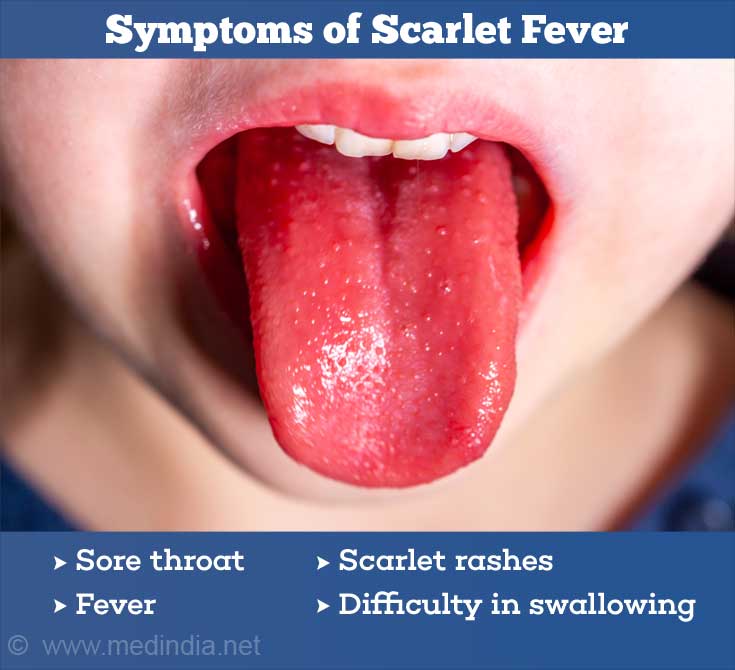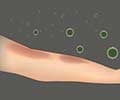- Scarlet fever - (http://www.nlm.nih.gov/medlineplus/ency/article/000974.htm)
- About Scarlet fever - (http://en.wikipedia.org/wiki/scarlet_fever)
About
Scarlet fever may follow a throat infection caused by bacterium Streptococcus pyogenes or group-A beta-hemolytic streptococcus. Symptoms typically appear in 1 to 7 days. Scarlet fever symptoms such as the scarlet rashes, red tongue and flushed face occur when the Streptococcus bacteria release toxins. These toxins get into the blood from the infected throat and make the skin go red with rashes.
Scarlet fever is widespread among children aged between 3 and 16 years, the most common age being 4 years. The disease occurs more often in late winter or in early spring.
Scarlet fever is contagious and gets transmitted from one person to another through fluids from the mouth and nose. When an infected person coughs or sneezes, the bacterium becomes airborne in droplets and could well be inhaled by others. Also, an untreated person with scarlet fever may well be contagious for several weeks, even after the symptoms have disappeared.
Once a person gets scarlet fever, it is very unlikely that they will suffer from it again.
Causes of Scarlet Fever
Scarlet fever is caused by infection from exotoxin-producing Group-A â-hemolytic streptococci bacteria called Streptococcus pyogenes. It produces exotoxins that get into the blood to cause the characteristic hallmark of red rashes.
Rare causes for Scarlet fever include-
- Infection with Group-C or Group-G streptococci.
- Scarlet fever following streptococcal infection from surgical wound infections, infection following child birth, or a burn injury.
- Staphylococcal scarlet fever is a mild form of staphylococcal scalded skin syndrome.
Severe, but rare forms of scarlet fever include:
- Streptococcal toxic-shock syndrome, a dangerous condition associated with intense toxemia, which may be life threatening.
- Scarlet fever with complications like meningitis, acute rheumatic fever or post-streptococcal glomerulonephritis.
Symptoms of Scarlet Fever
Patients with scarlet fever have the following clinical features-
- Sore throat and fever of 101 F (38.3 C) or higher, frequently with chills are the typical first symptoms.

- Bright red rashes (scarlet rashes) would then appear within 12 to 48 hours. The rash begins as small red spots or red blotches and soon turns into pink-red rashes that resemble sunburn.
- The rashes usually begin on neck, upper chest, armpits and behind the ears and soon spread to neck, elbows, inner thighs and groin, chest and some other parts of the body.
- The skin may feel rough like fine sandpaper when touched.
- The face and cheeks may become flushed and the lips turn pale. The rash blanches (becomes white) when it is pressed.
- The tongue becomes pale but coated with bright red spots with a "strawberry" appearance. After a few days, the whole tongue may look red.
- The areas of skin around the eyes, lips and nose are usually spared from this rash.
Other common symptoms in Scarlet fever include-
- Difficulty swallowing
- General malaise
- Headache
- Loss of appetite
- Nausea
- Vomiting
- Stomachache
- Itching
- Pastia's lines characterized by broken blood vessels in the folds / junctions of the body, for example the armpits, groin, elbows, knees and neck. These Pastia’s lines remain even after the rash is gone.
- Swollen lymph nodes that become tender to the touch.
The rash begins to fade after about six days from onset and peeling of flakes (desquamation) mainly from the face and the hands begins. Peeling of flakes from the palms and around the fingers starts about a week later. Peeling also occurs in axilla, groin and tips of the fingers and toes.
Diagnosis of Scarlet Fever
Usually, physical examination can confirm Scarlet fever. The characteristic rashes and other symptoms often make it quite easy for a doctor to diagnose scarlet fever.
A throat swab culture or a Rapid DNA test of the throat swab is done in-order to determine which bacteria have caused the infection. Sometime a blood test is also ordered.
Treatment of Scarlet Fever
Scarlet fever is treated with the following-
Antibiotics - A 10-day course of antibiotics is the most common treatment for scarlet fever. Patients who are allergic to penicillin may take erythromycin instead. Patients are advised to stay at home during the course of the antibiotic treatment.

Antibiotics used to treat scarlet fever include penicillin, cephalexin, amoxicillin, azithromycin, clarithromycin and clindamycin.
Patients should be advised to complete the entire course of the antibiotic.
Other treatments - Drinking plenty of liquids is recommended. The room temperature should be kept cool and the victim must be kept in isolation to avoid spreading of infection to others as well as to prevent other complications.
Paracetamol to relieve aches and pains, as well as to bring the fever down and calamine lotion to soothe itchy skin may be used.
Complications of Scarlet Fever
Complications of scarlet fever, if occur, would commonly include-
- Ear infection, including otitis media
- Throat infection and throat abscess Pneumonia
- Sinusitis
- Other skin infections
- Inflammation of the kidney(s) – post-streptococcal glomerulonephritis causing Chronic End-stage Kidney Disease
The following complications are possible, but very rare-
- Meningitis and brain abscess
- Necrotizing fasciitis
- Toxic shock syndrome
- Osteomyelitis - infection of the bone
- Rheumatic fever and Endocarditis
- PANDAS (Pediatric Autoimmune Neuro-psychiatric Disorders Associated with streptococcal infections)









